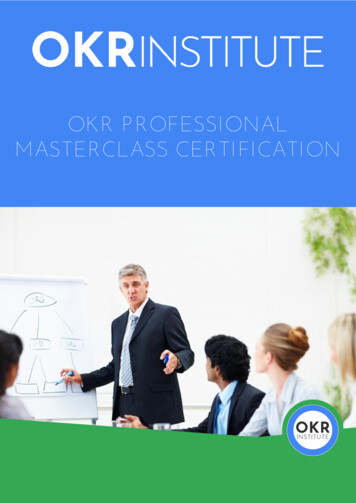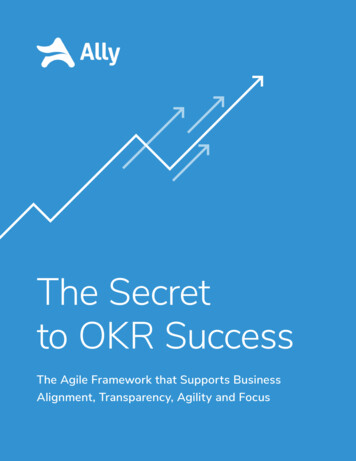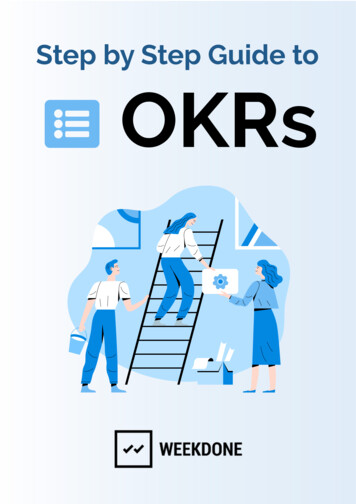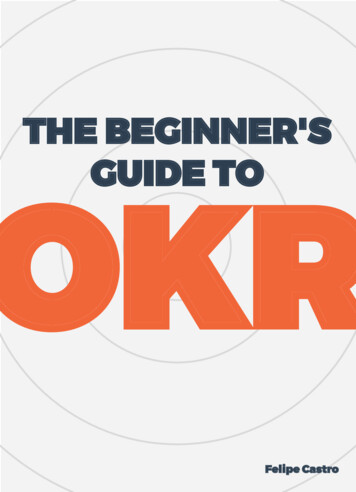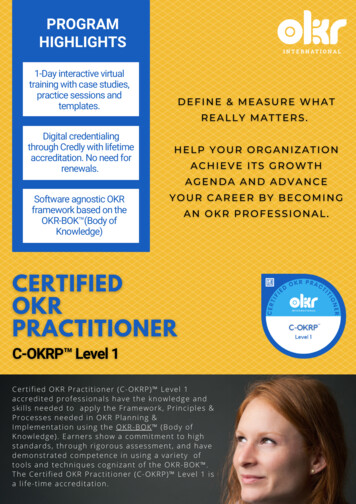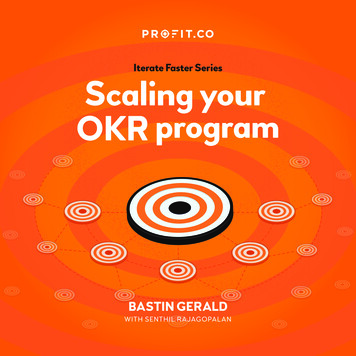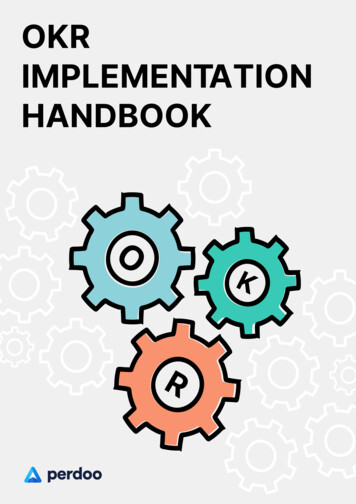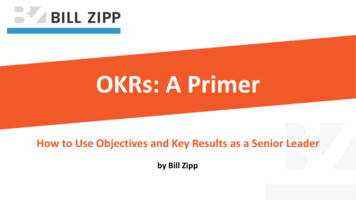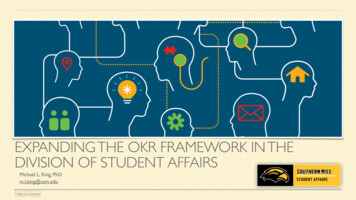
Transcription
EXPANDING THE OKR FRAMEWORK IN THEDIVISION OF STUDENT AFFAIRSMichael L. King, Phm.l.king@usm.eduDTable of Contents
EXECUTIVE SUMMAREXPANDING THE OKR FRAMEWORK IN THE DIVISION OF STUDENT AFFAIRS (SUMMARY PAGE 1 OF 2)When our students set out todiscover their path to the toptoward a Southern Missgraduation, we know what our students willneed along the way. Our desire to helpstudents reach this goal drives us to carryout our mission of developing healthy,connected, and learning-focused studentsand communities.We also know that more students todaythan ever before stand to bene t from ourprograms, services, physical spaces, andrelationships. Effective assessment andstrategic planning are among the practicesnecessary to improve and expand our effecton Southern Miss students.SACSCOC requires that universities provideevidence showing the use of program andservice assessment. Minimum standards areincreasing as the accreditation bodybelieves it’s important that this process“Goals at this level and duration are important, butthey have life only when segmented into smalleractions and assigned to team members.”legitimately bene ts students. Moreover,strategic planning efforts also require goalsetting, result analysis, and documentation ifexpected to be effective.Historically, our assessment documentationprocess has been department-centric with afocus on longer-term goals. Goals at this leveland duration are important, but they have lifeonly when segmented into smaller actions andinvolve team members directly. Whenassessment is a recurring expectation of all,everyone’s output improves.The Student Affairs Leadership Team (SALT)recognized these opportunities for improvement1. Meet accreditation requirements withadequately documented evidence,2. Challenge more staff members toimprove operations and programs, and3. Enhance our reach and effect onSouthern Miss studentsThe following pages detail this plan andprovide training for expanding the OKRframework in your respective departments.Y2fifiTable of Contentsand approved a plan early Spring 2020that is designed to:
EXECUTIVE SUMMAREXPANDING THE OKR FRAMEWORK IN THE DIVISION OF STUDENT AFFAIRS (SUMMARY PAGE 2 OF 2)“Effective assessment requires that we ‘Close the Loop.’We open loops by submitting OKRs after we set new goals.We close loops when we submit follow-up OKRs reportingobserved results, an analysis, and next steps.”Assistant, associate, and full directorsand their supervisors will complete aminimum of two OKRs each semester.Coordinators and managers mayparticipate in this process as well.Effective assessment requires that we“Close the Loop.” We open loops bysubmitting OKRs after we set newgoals. We close loops when wesubmit follow-up OKRs reportingobserved results, an analysis, and nextsteps. Participating staff members andsupervisors may use the OKR Guidewhen meeting to brainstorm, coordinate,and approve their OKRs.Effective coaching will facilitate thecreation of meaningful and missionfocused OKRs. While some OKRs maybe best set as a directive, those writtenwith both the supervisor’s andemployee’s input will more likelygenerate needed buy-in andcommitment. OKRs may focus on theassessment of individual workshops orevents, internal organizational processes,Table of Contentsmonthly revenue goals, strategicinitiatives, etc. Timelines are as exibleas needed and may even be as short asa few weeks.OKR managers will have the option toattend training sessions or access oncall consultations. As team membersbecome more familiar with this process,the better positioned we’ll become toensure Southern Miss students bene tfrom our efforts.Follow-through is everything. As datafor each OKR become available,managers must submit their results,analysis, and decisions within twoweeks. Complete submissionseffectively close the loop while alsosetting the stage for another set ofnewly imagined OKRs.Yfifl3
TABLE OF CONTENTEXPANDING THE OKR FRAMEWORK IN THE DIVISION OF STUDENT AFFAIRSEXECUTIVE SUMMARYIMPROVING OUR SYSTEMWhat's the Problem?Moving Toward a SolutionTHE ANATOMY OF AN OKRBreaking It DownExample OKRsUSING OKRS LIKE A PROCoach Staff Toward SuccessThe Action PlanClosing the LoopMAKING IT ALL WORTHWHILECascade OKRs to Unite TeamsCrowdsource SupportTHE APPENDIXDetailing the OKR GuideSubmission LinksKey Results Are Outcome StatementsReferencesTable of ContentsS4
IMPROVING OUR SYSTEMTable of Contents
IMPROVING OUR SYSTEWHAT’S THE PROBLEM?More students than ever before stand to benefit from our relationships, programs,and services.SACSCOC make their requirements clear—Accredited institutions must learn asmuch from failures as we learn from successes.Relying on annual goals only inhibit timely, actionable assessment practices.Previous assessment protocols did not adequately engage all necessary staffmembers in the process.Table of ContentsM6
IMPROVING OUR SYSTEMOVING TOWARD A SOLUTIONAll assistant/associate directors, directors, and SALT members have roles in this OKR project.Leadership may involve additional staff members as needed.Supervisors should coach their direct reports through the OKR Guide to set strategic goals.Participants must close the loop on at least two OKRs each semester.We open loops by setting goals and submitting OKR Forms (see submission links in Appendix).We close loops by making a second OKR submission which includes actual results, an analysis, and adescription of the followthrough decision. Submit these OKRs soon after the data becomes available.On-call assessment consultations are available to all DSA staff.Table of ContentsM7
THE ANATOMY OF AN OKRTable of Contents
THE ANATOMY OF AN OKBREAKING IT DOWNOBJECTIVESKEY RESULTSThe staff member’s main goalTogether define when objective is achievedContributes to organization strategyAll the qualities of SMART goals (link)ConsequentialBold but achievableLikely necessitates frequent updates(supervisor, team)May be process- and quality-focused (good vs. best)May be operational, programmatic, orlearning-focusedTable of ContentsRelies on valid and reliable measurementsProgrammatic, Operational, or Learning-Focused(learn more)R9
USING OKRS LIKE AN EXECUTIVEXAMPLE OKRSSolidify Southern Miss ConnectionsOBJECTIVEGalvanize students’ connections to Southern MissKEY RESULTIncrease Fall to Fall freshman cohort retention rate to 80%Table of Contents.E10
USING OKRS LIKE AN EXECUTIVEXAMPLE OKRSEncourage Healthy LivingExpand the use of healthy living practices among our campus-resident population.Increase the percentage of students reporting 6.5 hours of sleep eachnight by at least 20% compared to the previous fall.Less than 15% of campus residents will require alcohol-related conductproceedings by the beginning of Fall 2020 week 8.At last 50% of campus residents will use Payne Center programs or servicesat least twice by the Fall 2020 week eight.Increase the number of students reporting they are physically active (i.e., 30 minutes at least 3 times a week) by 20%.Table of ContentsE11
“They say that nobody is perfect. Then they tell you practice makes perfect.I wish they'd make up their minds.”–Winston ChurchillTable of Contents
USING OKRS LIKE A PROTable of Contents
USING OKRS LIKE A PRCOACH STAFF TOWARD SUCCESSEnsure team members write meaningful, important, and mission-focused objectives.Establish smart Key Results.Key Results may be operational, programmatic, or learning-focused (learn more).Discuss the method of measurement and timeline. Where and when will the data come from? In what form?Objectives are ‘achieved’ when well-written Key Results are met.Help team members exploit their strengths as they progress toward their objective.Inquire about progress privately to provide feedback, publicly to inform team members, andregularly to elevate importance.Celebrate the successes, build from the failures, open a new loop by submitting a new OKR.Table of ContentsO14
USING OKRS LIKE A PRTHE ACTION PLANGet team members started on the best path forward.An OKR without a plan of action is at best wishful thinking and at worse wasted time.Good OKR action plans require only the detail needed to inform DSA colleagues andpartners. They’ll need context and relevant detail, but not minutia.Some team members may need help getting started with a project. Use the actionplan section to sketch out the initial steps.Table of ContentsO15
USING OKRS LIKE A PRCLOSING THE LOOPThe Assessment CycleWithin two-weeks after data becomesavailable, submit a Closing the Loop OKR(submission link)Three Parts:1. The Data: Provide a description of theobserved data.2. The Analysis: What does this datamean? Was the KR achieved?3. The followthrough: How will yourespond? What did you learn?Table of ContentsDevelop Plans& OutcomesRevise/CreatePrograms orServicesUse & ShareData to InformDevelop Goalsfrom Mission orStrategic PlanDetermineAssessmentMethods &LogisticsCollect &Analyze DataEnact Plans;Deliver Programs& ServicesLoop Management: We open assessment loops bydeveloping or revising plans and outcomes (i.e., OKRs).We close assessment loops by measuring, analyzing, andlearning from the OKRs we complete.O16
MAKING IT ALL WORTHWHILETable of Contents
MAKING IT ALL WORTHWHILCROWDSOURCE SUPPORTOKRs will be made available to our DSA teammates and partners.DSA staff will be encouraged to review each other’s objectives and explorecollaborative opportunities where tting.When made available to the rest of the division, OKRs propagate interest andsupport for your goal individual and departmental goals.Table of ContentsEfi18
MAKING IT ALL WORTHWHILCASCADE OKRS TO UNITE TEAMSCascading OKRs (an optional use):Begin with high-level, broad organizationalgoals that get more specific wheninterpreted by frontline operations.Occur when a staff member’s OKRs arewritten to directly contribute to theirsupervisor’s stated key results.Promotes strategic synergy by linking thework of departments and individual teammembers across departments though broaddivisional goals.Table of ContentsE19
THE APPENDIXTable of Contents
THE APPENDIDETAILING THE OKR GUIDEDownload The GuideWho’s managingthis OKR?Enter the actualkey results.What’s theDSA Focus?What do theseresults mean?What’s theobjective statement?What decisionswere made?What’s this forThe OKR Guide is a helpful tool for sketching outnew OKRs. After approved by your supervisor,make it of cial by submitting your OKR online.X21?fiTable of ContentsDescribe the action plan.List those proposedkey results!
THE APPENDISUBMISSION LINKSLoop-Opening OKRsLoop-Closing ble of ContentsX22
THE APPENDIKEY RESULTS ARE OUTCOME STATEMENTSOPERATIONAL Key Results describe how well the operational aspects of a program oractivity are functioning. They help assess buildings, budgets, attendance, number ofprograms, satisfaction, wait times, etc.PROGRAMMATIC Key Results establish the desired overall impact of a program, service,or intervention. They track broad effects on campus communities for important metricssuch as retention and graduation rates, GPA, drinking or STI rates, campus af nity, etc.LEARNING Key Results detail the knowledge, skills, and/or traits students should gain orenhance as a result of their engagement with programs, services, or activities. Theyassess dimensions of AAC&U’s and CAS’s Essential Student Learning Outcomes.- Henning and Roberts, 2018Table of ContentsfiX23
THE APPENDIREFERENCESJohn Doerr’s Ted Talk, (2018)John Doerr’s book, Measure What Matters, (2018)Gaven Henning and Darby Roberts’ book, Student Affairs Assessment: Theory toPractice,p (2016).Table of Contents.X24
An OKR without a plan of action is at best wishful thinking and at worse wasted time. Good OKR action plans require only the detail needed to inform DSA colleagues and partners. They’ll need context and relevant detail, but not minutia. Some team members may
